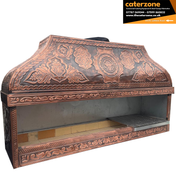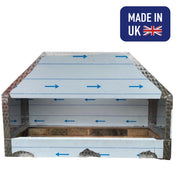Commercial kitchens need strict cleaning to keep everything hygienic and working well. Stainless steel cleaners are key to keeping equipment looking good and working right. This is true in all professional food prep areas.
Caterzone knows how hard it is for kitchen managers to keep stainless steel clean. They need good cleaning methods to stop germs, make equipment last longer, and follow health rules.
This guide will show you how to clean stainless steel properly. We'll cover removing stains, stopping rust, and protecting the surface. You'll learn how to keep your equipment looking and working great.
We'll talk about daily cleaning and advanced methods. Our tips will help kitchen staff deal with tough cleaning jobs well and professionally.
Understanding Stainless Steel Properties in Commercial Kitchens
Stainless steel is key in modern commercial kitchens. It's durable and performs well. Cleaning catering supplies is easier with stainless steel, keeping kitchens clean and efficient.
Commercial kitchens need strong materials. Stainless steel is perfect because it lasts long. It resists corrosion, heat, and bacteria well.
Types of Stainless Steel in Catering Equipment
- 304 Stainless Steel: Most common grade, excellent corrosion resistance
- 316 Stainless Steel: Superior chemical resistance, ideal for coastal regions
- 430 Stainless Steel: Magnetic grade, used in decorative kitchen surfaces
Common Causes of Stainless Steel Deterioration
Kitchen environments can harm stainless steel. Common problems include:
- Prolonged exposure to chlorides
- Incorrect cleaning techniques
- Physical damage from metal utensils
- Extreme temperature fluctuations
Benefits of Proper Maintenance
Regular maintenance is vital. It keeps equipment in good shape. Cleaning supplies properly saves money and keeps kitchens clean. Proper care protects your equipment and reputation.
Daily Cleaning Routine for Stainless Steel Surfaces
Keeping food service areas clean is key. A daily cleaning plan for stainless steel in commercial kitchens is essential. It keeps equipment and food areas safe and clean.
Effective daily cleaning has several steps. These ensure surfaces are clean and safe:
- Pre-service surface preparation
- Ongoing cleaning during service hours
- Comprehensive post-service deep cleaning
Kitchen staff need a clear cleaning plan for stainless steel. Start by removing loose debris. Then, use the right cleaning solutions and wiping techniques to avoid damage.
Important steps in daily cleaning include:
- Remove all removable components from equipment
- Use designated stainless steel cleaning products
- Wipe surfaces using microfibre cloths
- Rinse thoroughly with clean water
- Dry surfaces completely to prevent water spots
Following these steps daily keeps equipment in good shape. It also stops cross-contamination and ensures a safe kitchen for everyone.
Cleaning Tips for Stainless Steel Catering Equipment
Keeping stainless steel catering equipment clean needs special knowledge and care. It's vital to follow professional cleaning methods to keep your kitchen equipment in top shape.
Recommended Cleaning Products and Solutions
Choosing the right cleaning products is key for good equipment care. Kitchens should use special cleaners made for stainless steel.
- Non-abrasive stainless steel cleaners
- Mild detergent solutions
- Soft microfibre cloths
- Specialised stainless steel polishing agents
Step-by-Step Cleaning Process
Cleaning equipment in a commercial kitchen needs a clear plan. This method keeps your gear safe and clean.
- Remove loose debris and food particles
- Prepare appropriate cleaning solution
- Wipe surfaces using soft cloths
- Rinse thoroughly with clean water
- Dry completely with fresh microfibre cloth
Safety Precautions During Cleaning
When cleaning, safety is a top priority. Workers must handle chemicals carefully and wear the right gear to avoid accidents.
- Wear protective gloves
- Use eye protection
- Ensure adequate ventilation
- Follow manufacturer's cleaning instructions
- Store cleaning chemicals securely
Preventing and Removing Rust from Catering Equipment
Keeping stainless steel catering equipment in good shape is key. It can rust if exposed to certain conditions. This can harm its structure and look.
It's important to know why rust happens. Moisture, salt, acidic things, and damage can cause it. This is true for stainless steel surfaces.
- Identify places where rust might form
- Regularly clean and check the equipment
- Use protective coatings
- Fix any damage quickly
Professional kitchens can stop rust from forming. They clean with special cleaners, dry well, and avoid harsh tools. These steps help a lot.
If rust does show up, act fast. Use soft brushes, special cleaners, and polish to fix it. For big damage, experts might be needed.
- Clean the area well
- Use a rust remover
- Scrub gently with soft tools
- Rinse and dry fully
- Apply a protective layer
Looking after your equipment and being careful is the best way. It keeps stainless steel in top condition and stops rust.
Professional Cleaning Solutions and Chemical Safety
Food service sanitation needs careful attention to chemical use and safety. Stainless steel cleaners are key to keeping kitchens clean. Knowing how to use cleaning agents right is important for keeping equipment and staff safe.
Choosing and using cleaning solutions correctly is vital. Commercial kitchens must follow strict rules to protect staff and gear.
Approved Cleaning Agents for Commercial Use
- Chlorine-based sanitisers for surface disinfection
- Quaternary ammonium compounds for thorough cleaning
- Specialised stainless steel cleaners for food service
- Acid-based descaling solutions for mineral deposits
Chemical Storage and Handling Guidelines
- Keep chemicals in locked cabinets
- Store different cleaners separately
- Use colour-coded containers to avoid mixing
- Make sure labels are clear
Emergency Response Procedures
Kitchen staff need to know how to handle chemical emergencies. Quick action can reduce risks from spills or exposure. Always have protective gear like gloves and eye shields ready.
Using strong safety measures with professional stainless steel cleaners makes food service areas clean, safe, and up to code.
Maintaining Stainless Steel Finish and Appearance
Catering equipment care is key to keeping stainless steel surfaces looking great. In professional kitchens, special polishing methods are used. This keeps the equipment looking good and working well.
There are a few important steps to polish stainless steel surfaces:
- Use microfibre cloths for gentle, streak-free cleaning
- Select specialised stainless steel cleaning solutions
- Always wipe in the direction of the metal's grain
- Avoid abrasive materials that might scratch surfaces
Regular care stops water spots, fingerprints, and corrosion. Chefs and kitchen managers should clean daily. This keeps the equipment looking great and ensures it's clean.
When polishing, choose cleaning products made for commercial kitchens. Stay away from harsh chemicals that can harm the metal. Use soft, lint-free cloths and gentle circular motions to bring back the shine.
Looking after catering equipment is more than just cleaning. Deep cleaning and professional maintenance are also important. They help your kitchen equipment last longer and work better.
Advanced Cleaning Techniques for Stubborn Stains
Professional restaurant equipment maintenance needs special skills for tough cleaning jobs in commercial kitchens. Stainless steel surfaces often get hard stains. These need careful cleaning to keep equipment in good shape and clean.
Here are some top cleaning methods for tackling hard surface problems:
Heat Discolouration Treatment
High heat from cooking can stain stainless steel equipment. Experts suggest certain ways to fix this:
- Use special stainless steel cleaners for heat-stained surfaces
- Apply soft polishing compounds to remove surface stains
- Choose non-abrasive cleaners to avoid scratching
Calcium Deposit Removal
Calcium build-up is a big problem in commercial kitchens. Here's how to tackle it:
- Start with white vinegar solutions
- Use commercial descaling agents made for kitchen gear
- Regular maintenance is key
Oil and Grease Management
Oil and grease are hard to get rid of. Professional cleaning methods use degreasing agents. These agents break down tough grease without harming stainless steel.
Using these advanced methods keeps equipment working well. It also keeps kitchens very clean and safe.
Preventive Maintenance Schedule and Best Practices
Keeping foodservice hygiene high is all about a good maintenance plan for kitchen gear. Regular cleaning and upkeep are key to making sure stainless steel tools work well and last long.
A good maintenance schedule should include a few important steps:
- Daily surface cleaning and sanitisation
- Weekly deep cleaning procedures
- Monthly equipment checks
- Quarterly detailed maintenance checks
Training staff is vital for keeping cleaning standards high. A strong training program helps team members learn the right cleaning methods and how to care for equipment.
Here are some top tips for preventive maintenance:
- Make a standard cleaning checklist
- Use the right cleaners for stainless steel
- Keep records of all maintenance work
- Get professional checks on equipment regularly
Being proactive with maintenance cuts down on equipment downtime and saves money. It also keeps foodservice hygiene at its best. By focusing on regular cleaning and care, commercial kitchens can make their equipment last longer.
Equipment-Specific Cleaning Guidelines by Caterzone
Keeping catering equipment clean needs special knowledge for each appliance. Caterzone offers detailed cleaning tips for kitchen pros. This helps keep stainless steel gear in top shape. It also makes sure food is prepared in a clean environment.
Each Caterzone cleaner is made for certain kitchen machines. For example, refrigerators need soft cleaners to avoid scratches. Commercial ovens, on the other hand, need cleaners that can handle high heat. Food prep tables must be sanitised often to stop bacteria and keep surfaces clean.
It's important for kitchen staff to know how to clean each piece of equipment right. Dishwashers need special cleaning to avoid clogs, while prep tables need soft cloths and gentle cleaners. Always follow the manufacturer's cleaning instructions to avoid damage and keep equipment working well.
Keeping equipment in good shape means regular checks and cleanings. Caterzone suggests using top-notch cleaning methods to protect your investment. These targeted cleaning plans help kitchens work better and stay clean.
FAQ
How often should I clean stainless steel catering equipment?
Clean your stainless steel equipment every day. Wipe down surfaces after each use. Do a deep clean once a day. High-touch areas need extra cleaning to stay clean.
What are the best cleaning products for stainless steel surfaces?
Choose cleaners made for stainless steel that are pH-neutral. Stay away from harsh cleaners and chlorine. Use mild detergents or white vinegar to clean effectively without damaging the surface.
How can I prevent rust on my stainless steel catering equipment?
Keep surfaces dry after cleaning to prevent rust. Use a soft cloth to remove all moisture. Don't leave wet cloths on the surface. Check for rust regularly and fix it fast.
What direction should I clean stainless steel surfaces?
Clean in the direction of the metal's grain to avoid scratches. Use soft, non-abrasive cloths or microfibre materials for cleaning.
Are there any cleaning techniques to avoid on stainless steel equipment?
Don't use steel wool, wire brushes, or harsh cleaners that can scratch. Avoid bleach and chlorine-based cleaners. They can damagethe protective layer. Also, don't use cleaning tools with carbon steel to prevent rust transfer.
How do I remove stubborn stains from stainless steel?
For tough stains, make a paste with baking soda and water. Apply it gently with a soft cloth. Use a degreaser for grease and oil. For calcium deposits, try a vinegar solution or a limescale remover made for stainless steel.
What safety precautions should I take when cleaning stainless steel equipment?
Wear gloves and eye protection when cleaning. Make sure the area is well-ventilated. Follow the instructions on each cleaning product. Keep cleaning solutions away from food areas and store them safely.
How can I maintain the shine of stainless steel surfaces?
Use a stainless steel polish to restore shine and protect the surface. Buff with a soft microfibre cloth, always in the direction of the grain. Avoid over-polishing to prevent damage.



